UNStudio
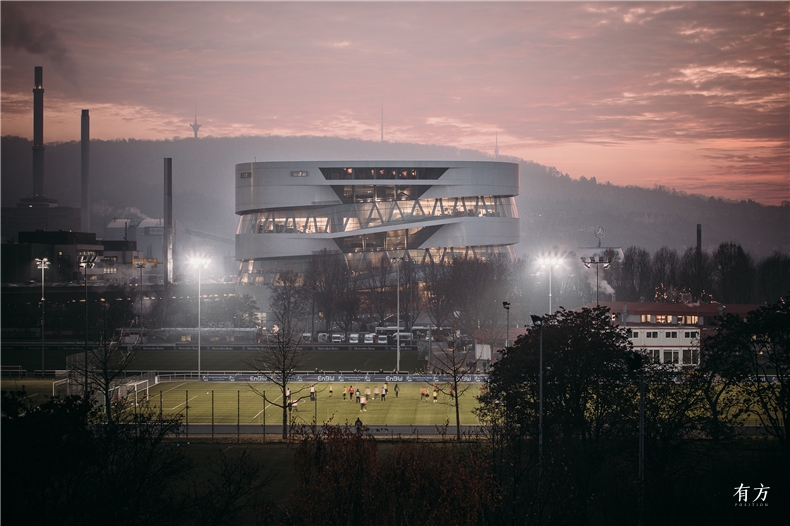
设计单位 UN Studio van Berkel & Bos, Amsterdam
项目地点 德国,斯图加特
建筑面积 约53,000平方米
建成时间 2006年5月19日
撰文 Ben van Berkel, Caroline Bos
梅赛德斯—奔驰博物馆会让每个人忘记自己身在一座博物馆里。让传统博物馆越来越不可持续的那些问题,在这里统统没有出现。包围着你的作品所讲述的文化,都是关于你的;它们甚至比今天大多数的艺术作品要更加让人亲近。我们下意识地发现:现在当你走进纽约现代艺术博物馆(MoMA),第一个接触到的物件并不是什么艺术作品,而是悬挂在头顶的一架直升飞机。这架直升飞机讲述了我们的社会所取得的成就和存在的问题,就像在梅赛德斯—奔驰博物馆里的那些汽车一样。
The Mercedes-Benz Museum makes everyone forget that they are in a museum. None of the problems that make the traditional museum less and less sustainable occur. The works around you belong to no other culture than your own. They are much closer to you and speak more clearly to you than most of today’s art. Subliminally, we already know this: now, when you enter the MoMA in New York, the first important object you encounter is not art, but a helicopter that floats above your head. The helicopter speaks to us about the achievements and the problems of our society, as do the cars and their history in the Mercedes-Benz Museum.
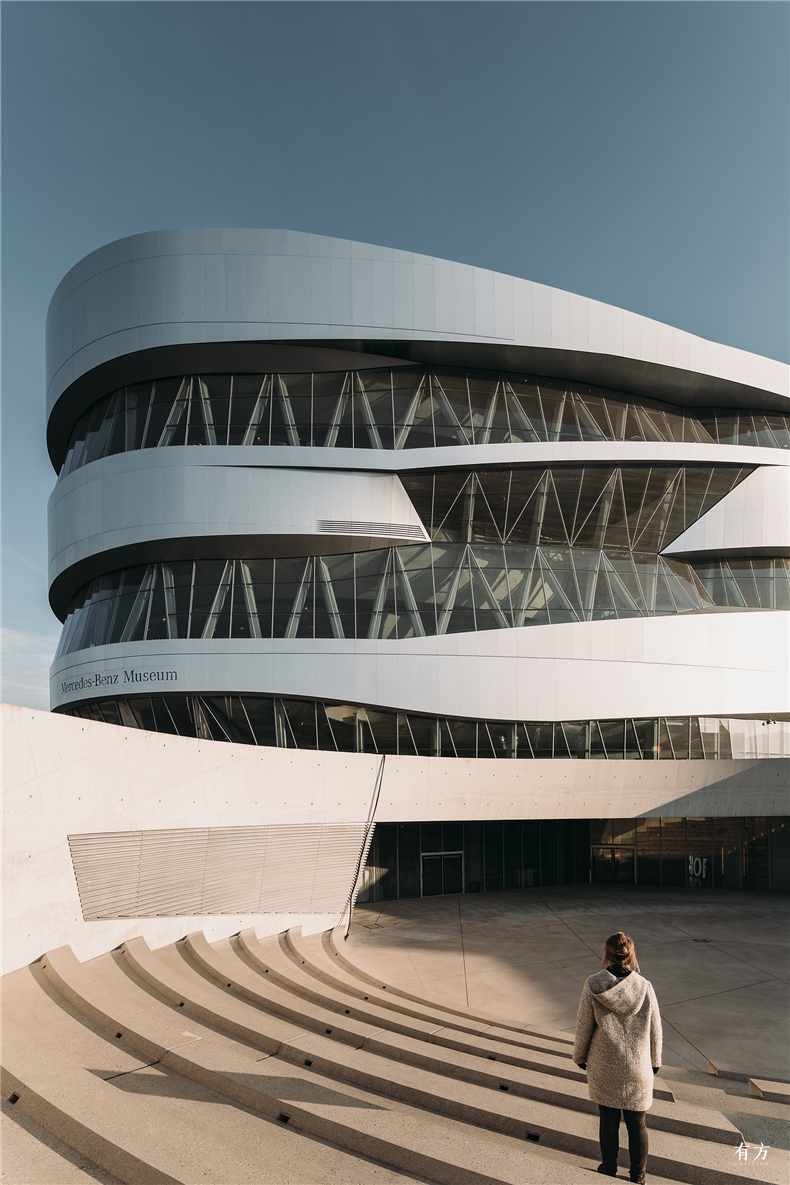
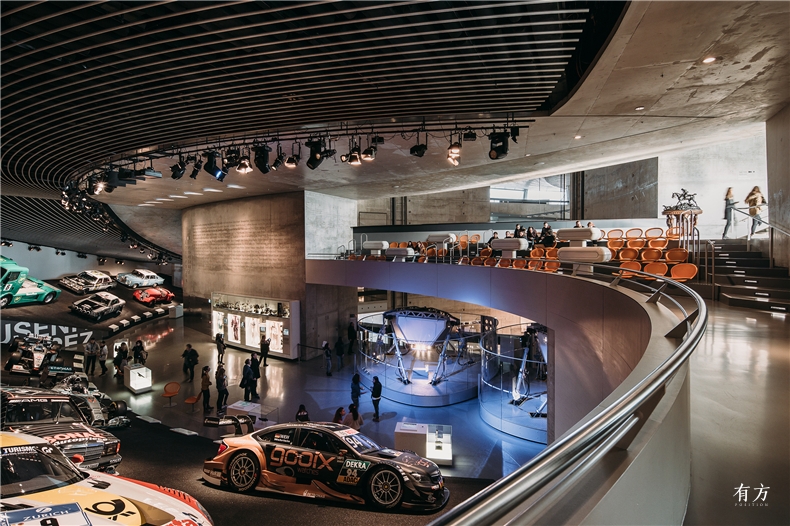
人们喜欢去逛博物馆,但他们喜欢的是特别的博物馆,比如喜欢埃尔格列柯或维米尔的作品以流动的方式去展示一样。在这类博物馆里,人们可以获取更多信息。不像在空荡荡的仓库似的博物馆里闲逛,却只能看到各种艺术展品的一点皮毛。位列综合型博物馆金字塔顶端的是法国的卢浮宫博物馆,位于底端的是伦敦的V&A博物馆——这全看精华展品在全部展品中是否占有合适的比例。当下,所有优秀的、顶尖的艺术作品均已就位。未来的主要展览形式将是专业化展览,这样不但可以有效地进行交流,还可以比毫无方向的综合型展览更能激发文化的发展。
People like going to museums, but above all people like going to special museums, just as they like those roving monster shows showing all the works of El Greco or Vermeer. They just get more out of them than wandering aimlessly around all those big warehouse type of museums that have a bit of everything. At the top of the scale of the generalist museum is the Louvre; at the bottom is the V & A – it all depends upon the right proportion of highlights in relation to the rest. Today, the exceptional, top pieces are all in place. The future therefore belongs to specialist collections that communicate strongly what they are about and in this way stimulate culture far more than generalist collections without direction.
艺术和手工艺作品的展示有自己的历史、自己的传统和自己的规则。我们喜欢挑战这些惯例,因为一切永远都有变得更好的可能。新鲜的、和往常不一样的事物总是很有吸引力。即使这些展览方式最终没有解决问题,他们也还是能让每个人知道事物可以用这些全新的方式去看待。
The display of art and artifacts has its own history, its own traditions, and its own dogmas. We like to challenge these conventions because everything can always be better. Things that are new and different are appealing. Even if eventually they don’t work out, they will have fulfilled a role in making everyone see stuff in a fresh way.
与此同时,我们担心的是目前人们对博物馆建筑的兴趣几乎超过了对其内部展品的兴趣。文化所创造出的东西值得收获更多的关注。所以无论艺术高级或低级,我们希望把艺术放回本应属于它们的基座上。我们的博物馆目标是让其中的展品看起来与世界上最大的商店中的商品一样好,这样他们就会收获同样多的关注和憧憬。
At the same time, we worry about the fact that at the moment the interest in the architecture of museums almost surpasses the interest in the works that are inside them. The objects that culture produces deserve more attention. We want to put art, high and low, back on its pedestal. Our museological ambition is to make the objects in the museum look just as good as the merchandise in the greatest shops in the world, so that they fascinate and evoke the same amount of admiration and longing.
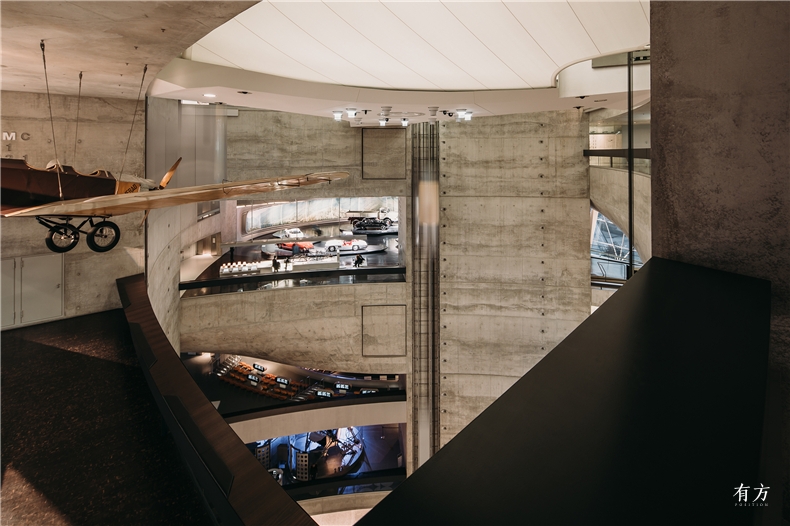
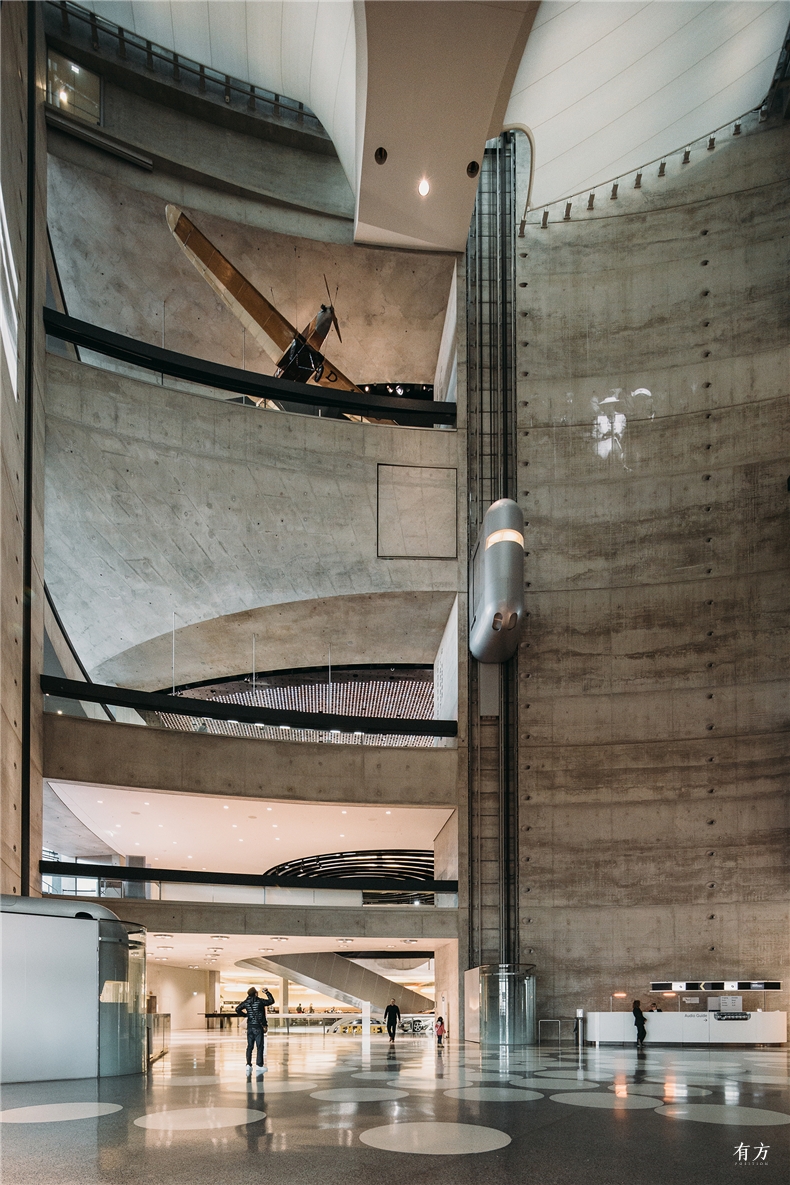
我们谈到要把艺术品放回本应属于它们的基座上,这并不是在打比方。基座对于创造绝佳视点来说十分必要;每一个作品都必须要有专属的精确的基座,而经典和现代雕塑家深谙此道。创造基座的大师有贝尼尼和布朗库西。在梅赛德斯—奔驰博物馆里,我们做的事情和他们一样,只不过需要在一个更大的尺度上实施而已。
When we say we are thinking about putting the objects in the museum back on pedestals we mean this less metaphorically than literally. Pedestals are vital in generating the right viewpoints; each work must have its own, precise platform. Classical and Mode sculptors knew this. The masters of the pedestal are Beini and Brancusi. In the Mercedes-Benz Museum we do exactly the same as they did, but on a larger scale .
我们将基座整合到了建筑中。不同于将基座独立设置,我们在“Legend Rooms”设置了半圆形坡道,使观览产生不同的视角。当你在坡道周围走动时,可以看到汽车从或高或低、或近或远、正面的或者倾斜的角度交替出现。你可以通过一架很高的楼梯进入“收藏区”,然后你会发现自己正处在与汽车等高的位置上。 也许你可以说,在梅赛德斯—奔驰博物馆里,被放置于基座上展示的正是观者自己。
We integrate the pedestal into the architecture. Instead of individual plinths, in the Legend Rooms we have made semi-circular ramps to generate different perspectives. You see the cars alteately from higher, lower, closer and more distant, frontal and more oblique points of view as you move around them. In the Collections Rooms you gain access via a high staircase and then you find yourselves at equal level with the cars. Maybe you could say that in the Mercedes-Benz Museum it is the visitor who is put on a pedestal.
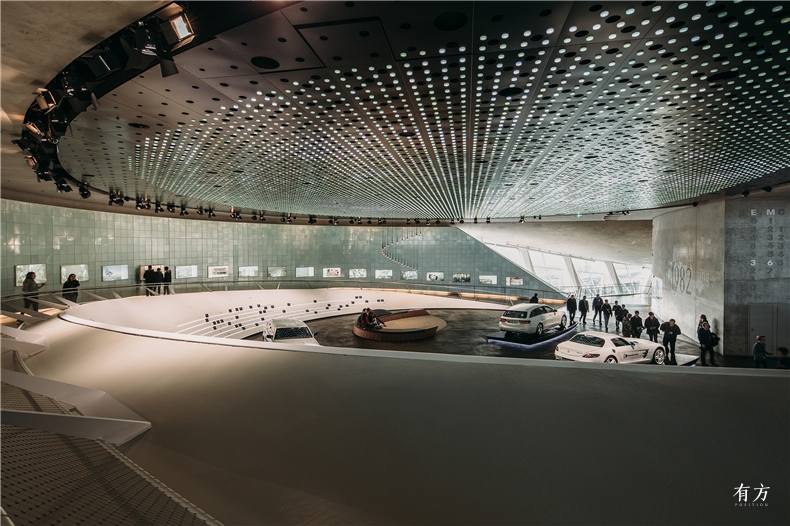
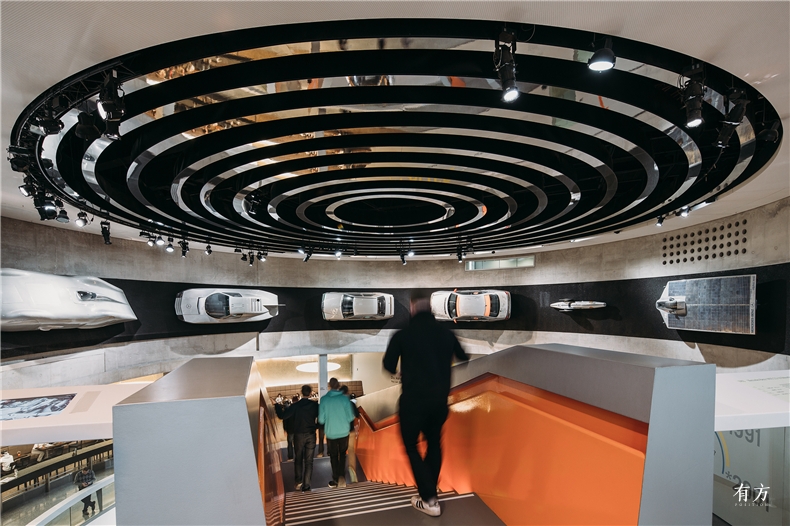
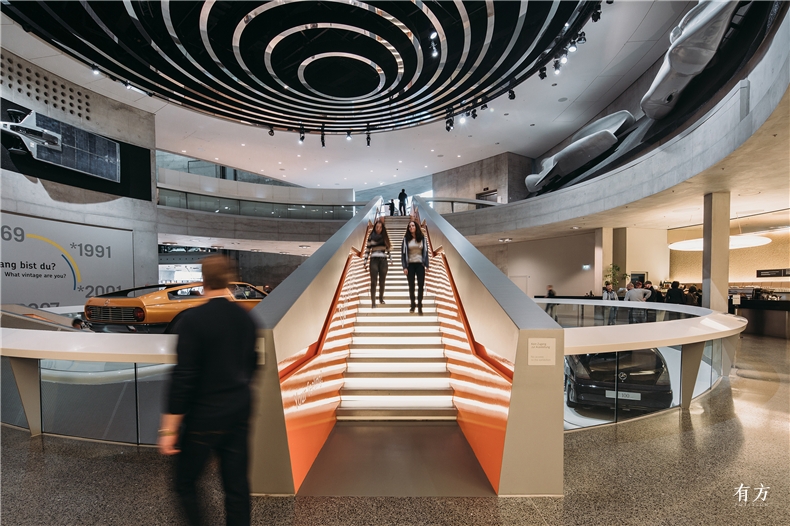
从几个不同的高度观赏三叶草形状的展览空间可带来全景式的概览。我们不仅对帮助参观者聚焦于某样展品感兴趣,还希望帮助他们了解与整个展览有关的个人作品。长长的基座和全景房间共同构成了一种新型博物馆空间,以此应对那些我们通常在博物馆中不喜欢的空间布局。例如,我们不喜欢过大或过高的房间,当你进入房间时,感觉就像是一巴掌拍过来,从来不让你看到整个房间。我们的目标是创造一个能够激发思考的环境,而不受限于某个固定的领域。我们希望通过将作品与其附近的其他作品、其所在的空间以及外部世界相关联来实现强烈的视觉体验。在梅赛德斯—奔驰博物馆里,你可以看到汽车以外的东西,看到外面的路,以及斯图加特郊外连绵起伏的丘陵上的葡萄园。
Viewing the leaf-shaped exhibition spaces from variable heights generates panoramic overviews. We are not just interested in helping the visitor to find a focus on each object, but also in the question of the perception of the individual work in relation to the exhibition as a whole. Together, the long pedestal and the panoramic room produce a new type of museological space, reacting against spatial arrangements that we dislike in museums. We don’t like, for instance, rooms that are overly large or high, which, when you enter them, feel like a slap in the face and which never let you see the whole. It is our ambition to make an environment that stimulates contemplation, but by other means than enforcing a restricted optical field. We want to achieve an intense visual experience by relating the work to the space it is in, to other works in its vicinity, and to the outside world. In the Mercedes-Benz Museum you can look past the cars and see road outside, and beyond that the vineyards on the rolling hills at the outskirts of Stuttgart.
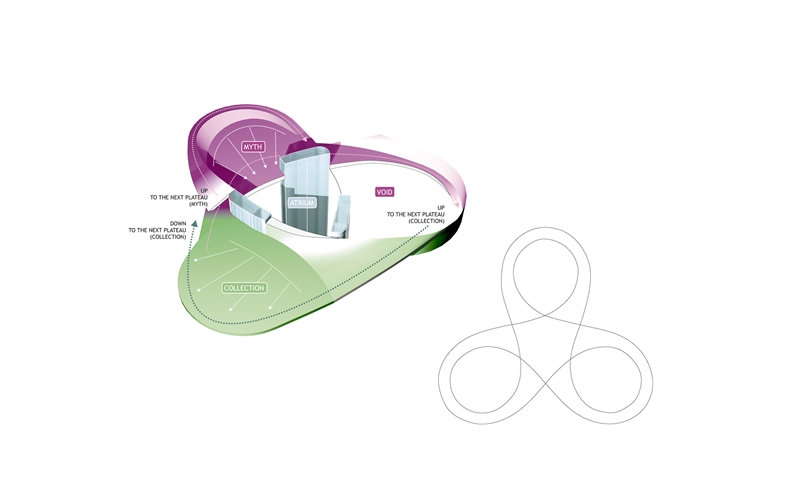
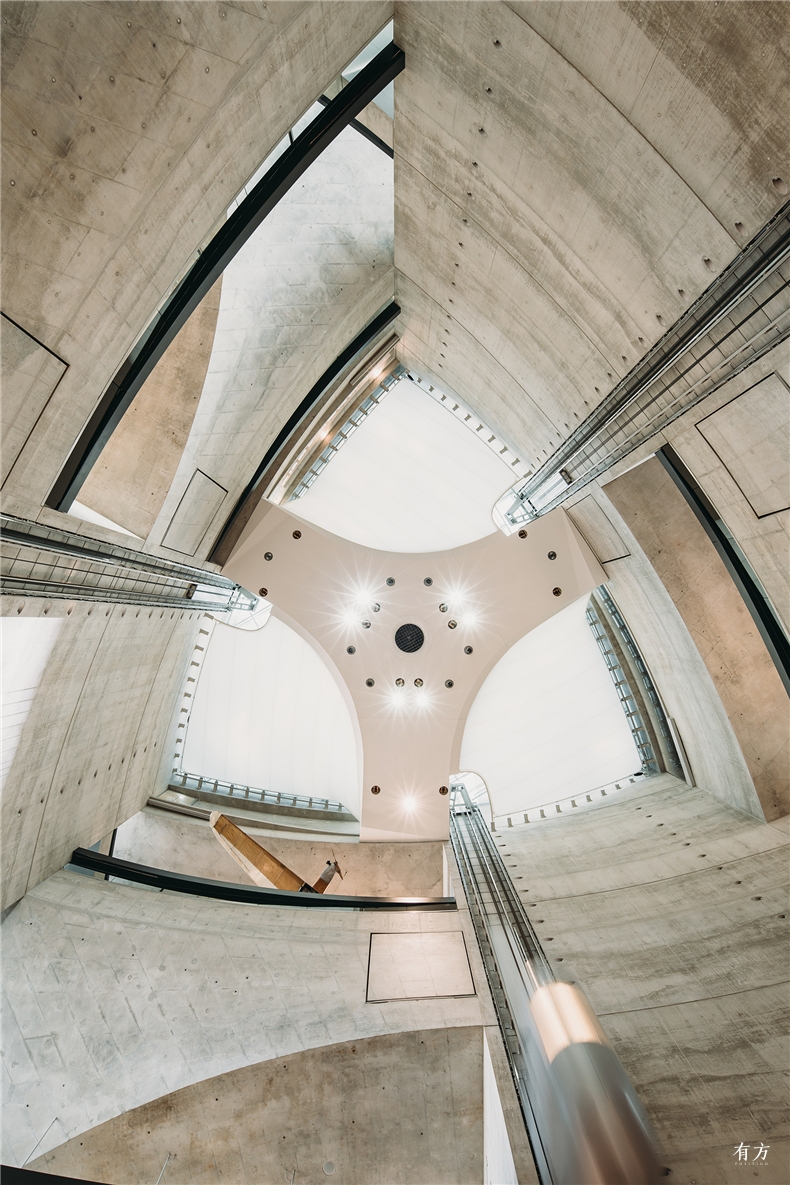
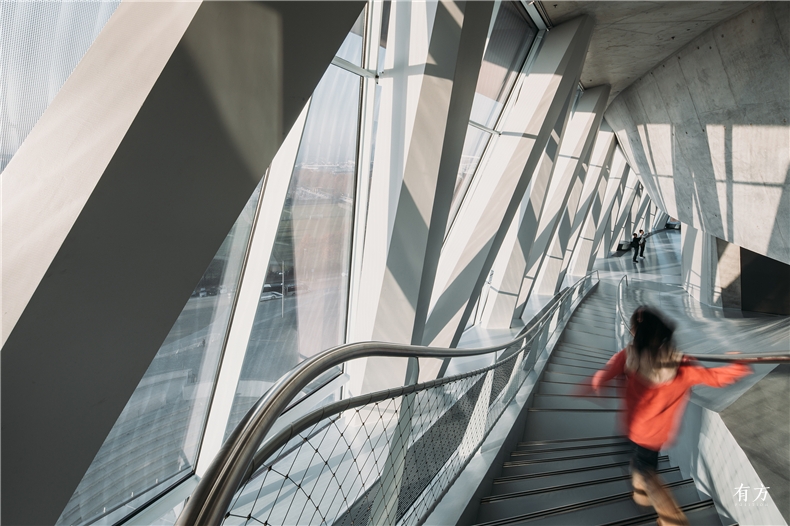
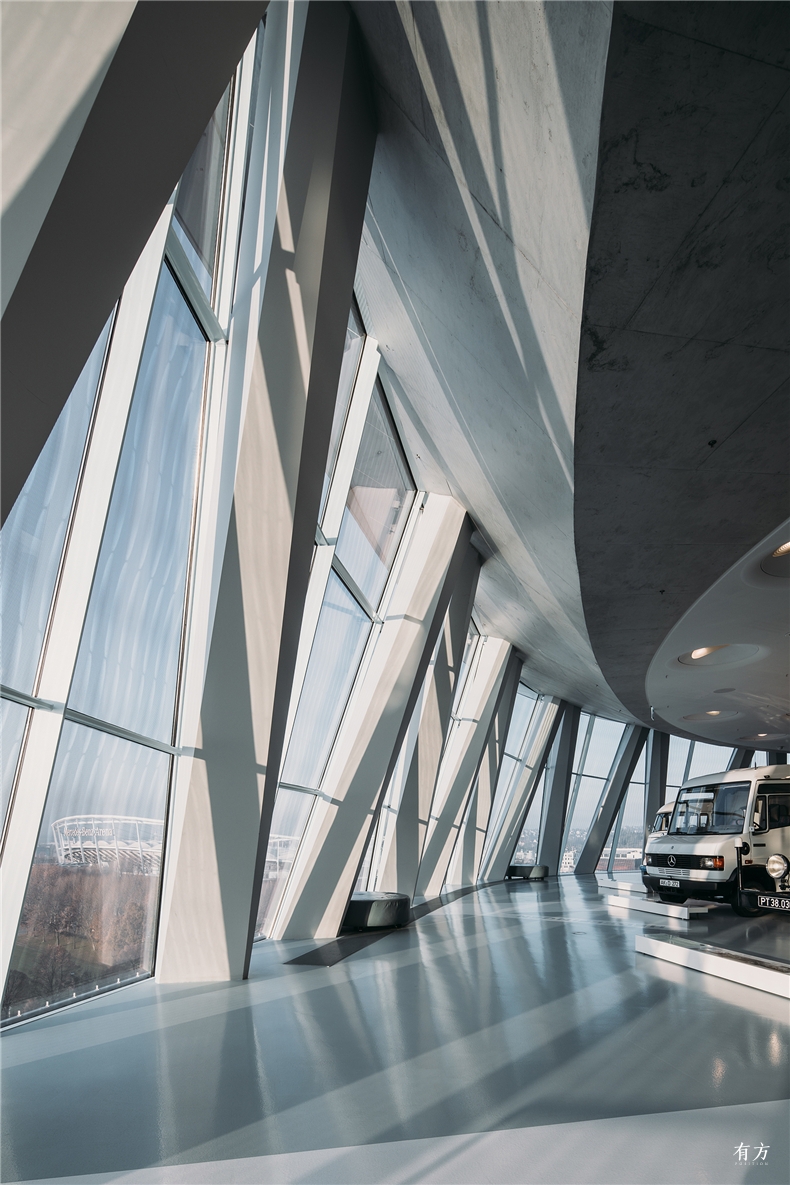
博物馆结构的成功取决于其内部空间布局的创造性和恰当性。并不是拥有一个很酷的外观就可以让一座博物馆变得伟大。为了解释梅赛德斯—奔驰博物馆的独特结构,我们将它与三座对20世纪博物馆形成巨大影响的建筑物进行了比较。
The success of a museum structure depends upon the inventiveness and adequacy of its inteal arrangement of spaces. It’s not the iconic face that makes a museum great. To explain the unique structure of the Mercedes-Benz Museum we compare it to three buildings that have made an enormous difference to museum architecture in the twentieth century.
位于柏林,由密斯·凡·德·罗设计的国家美术馆,其亮点是大跨度,无柱的展览室。梅赛德斯—奔驰博物馆由于其复杂的承重结构也实现了这种自由的展览空间。当这种结构系统与参观流线结合起来,就实现了最具挑战性的博物馆结构:弗兰克·劳埃德·赖特设计的纽约古根海姆博物馆。古根海姆博物馆用坡道环绕着内核,但在梅赛德斯—奔驰博物馆中,参观者可以选择两种在交织一起的螺旋形中的一种中去行走,可向上也可向下返回至地面。
The National Gallery by Mies van der Rohe in Berlin is characterized by large-span, column-free exhibition rooms. The same effect of free, unobstructed spaces flowing into each other is achieved in the Mercedes-Benz Museum thanks to its intricate load bearing construction. This construction system, in tu, is integrated with the circulation system, which takes up and transforms the most challenging museum structure of all: Frank Lloyd Wright’s Guggenheim in New York. The Guggenheim ramp circles down the inner core, but in the Mercedes Benz Museum the visitors take one of two interweaving spirals down.
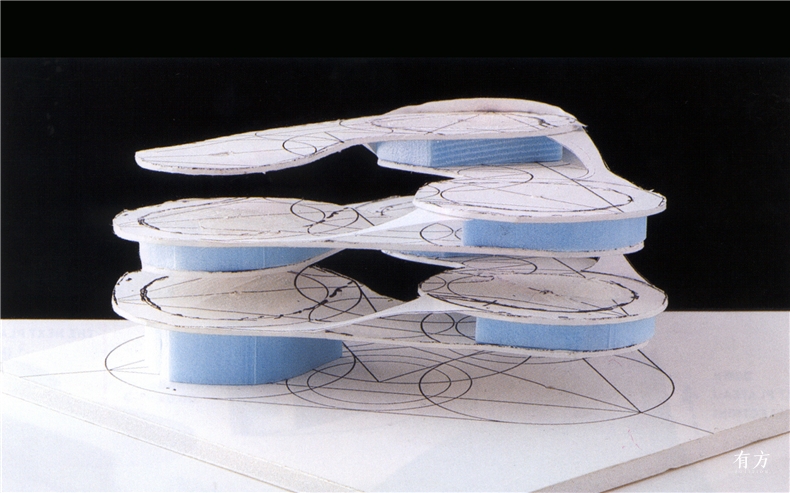
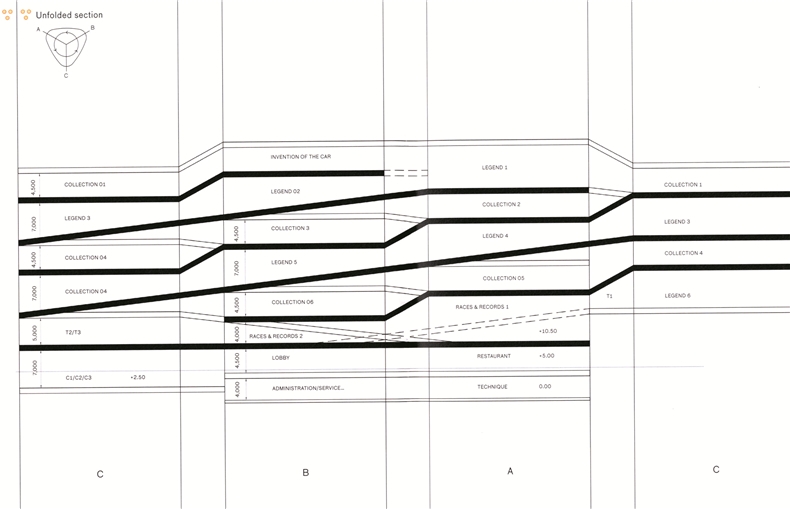
在罗杰斯和皮亚诺的巴黎蓬皮杜艺术中心,这种流线系统被放置在建筑物的外面,使周围环境更加活跃,并向公众展现出极具吸引力的姿态。蓬皮杜艺术中心通过技术装置来革新建筑。梅赛德斯—奔驰博物馆也将设施布置提升到与建筑设计同等重要的地位,但并不是将它们暴露出来,而是将它们融入到包容性的设计理念中。
This circulation system, like Rogers’ and Piano’s Centre Pompidou in Paris is placed on the outside of the building to enliven the surroundings and to make a compellingly inviting gesture to the public. The Centre Pompidou revolutionized architecture by making a play of the technical installations. The Mercedes-Benz Museum also elevates the installations to the status of architecture, not by exposing them but by incorporating them in an inclusive design philosophy.
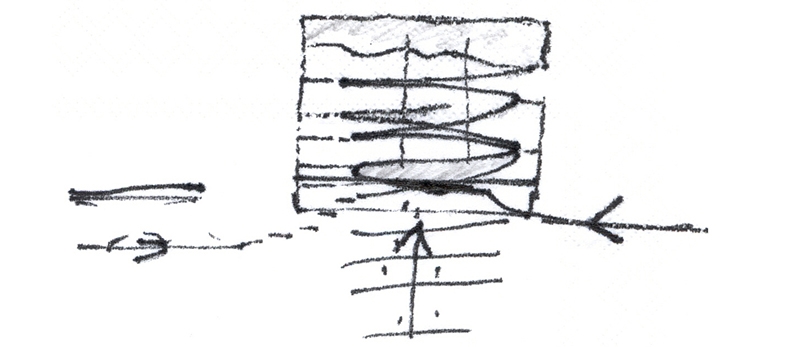
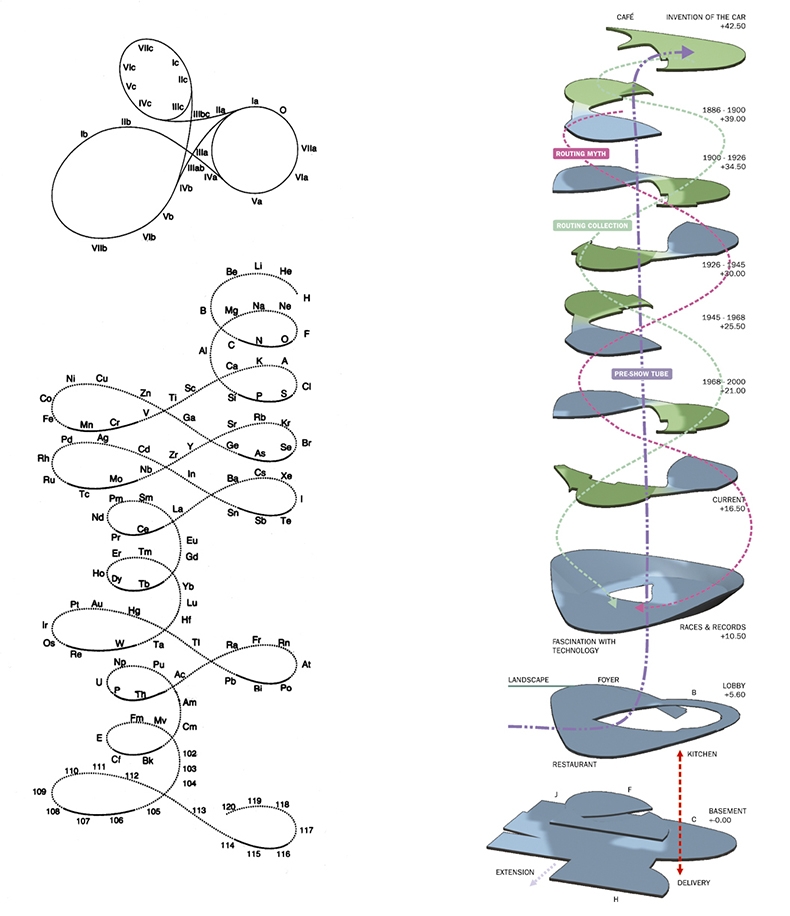
梅赛德斯—奔驰博物馆的设计将几个激进的空间原理结合在一起,从而创造出一种全新的博物馆类型。它部分是为了响应其作为博物馆的功能,部分是为了回应基地周边的情况,部分是为了回应属于建筑学本身的问题和疑虑。有一个在过去三十年左右带来了很多建筑思考的问题,那就是用更加动态的倾斜外形来替代现代主义立方体。非直线和平面的应用从一开始就出现在我们的工作中,我们的老师和寻找到历史事例都在现代主义的传统之外。但建筑师会用不同的方式来解释“倾斜”:对每个建筑师来说,“斜线”就意味着另类的、和现在不一样的东西。
The art of the Mercedes-Benz Museum is that it binds together several radical spatial principles, and generates a wholly new typology as a result. It does this partly in response to its museum function, partly in response to its peripheral situation, and partly in response to questions and conces that belong to the discipline of architecture itself. One question that has generated a lot of architectural thinking for the last three decades or so, has been the replacement of the modeist cube by a more dynamic constellation of oblique surfaces. The application of non-straight lines and planes has been present in our work from the beginning. The teachers and historic examples we sought out have all worked outside the Modeist tradition. But architects interpret the oblique in different ways; to each architect the slanting line means something else.
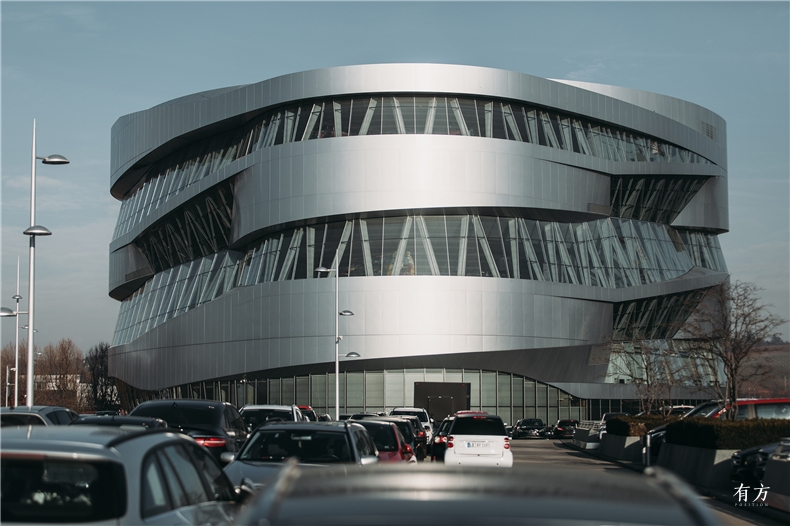
我们专注于将“倾斜”作为促进流动性、方向感以及人们在建筑物中交流的手段。在墙壁,地板和天花板上设计出一定的角度,可以让眼睛注意到一些东西。重复使用这些元素反而会带来意外静谧的环境效果。因为这样的倾斜条件对于博物馆来说是理想的,它可以将分散空间的注意力最小化。特别是像在梅赛德斯—奔驰这样的博物馆里,重复使用的倾斜元素,还与另一种建筑元素——曲线相结合。倾斜表面与对称曲线的融合,使建筑物的平面图和外墙上呈现出深度不相对称的空间。
We have focused on the oblique as a means to stimulate mobility, the sense of direction, and the communication between people in buildings. The use of angles in walls, floors and ceilings gives the eye something to focus on; the repetition of these elements paradoxically results in environments that are experienced as tranquil. As such the oblique condition is ideal for the museum since it brings into being spaces that provide minimum distraction. Especially, when, as in the Mercedes-Benz Museum, the repetition of oblique elements is combined with another architectural ingredient with which we have experimented profusely: the curve. The merging of oblique surfaces with symmetrical curves, engendering deep, asymmetrical spaces is found in the plans and the facades of the building.

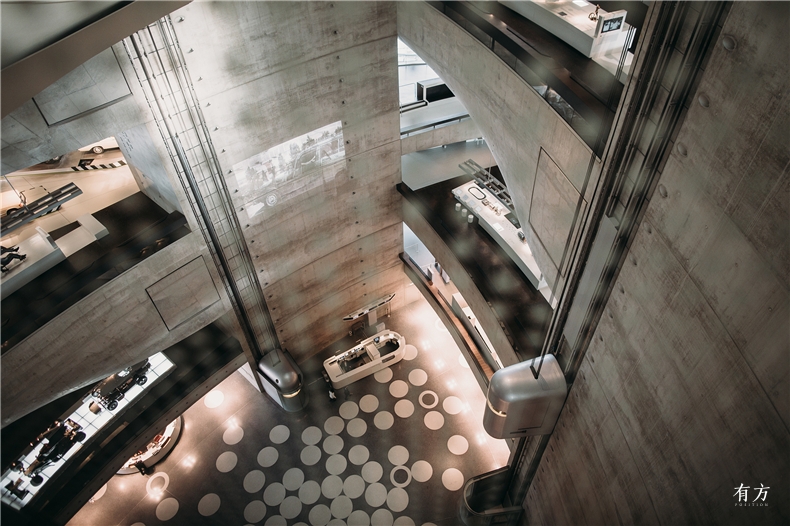
曲率和倾斜度的融合产生出折叠的地平面,这一1990年代的建筑主题,在梅赛德斯—奔驰博物馆不着痕迹地体现出来。因为它已被吸收到建筑的结构体系中、日光装置中,以及将两种不同的展览空间再次分离和汇集的布置中。
The fusion of curvature and obliqueness produces folding surfaces – the great architectural theme of the 1990-s. The fold, usually incaated in a very visible way, has in the Mercedes-Benz Museum become invisible under our self-imposed regime of inclusiveness. It has become absorbed into the building’s construction, structure-giving system, daylight-bringing device, and arrangement for separating and bringing together again the two types of different exhibition spaces.
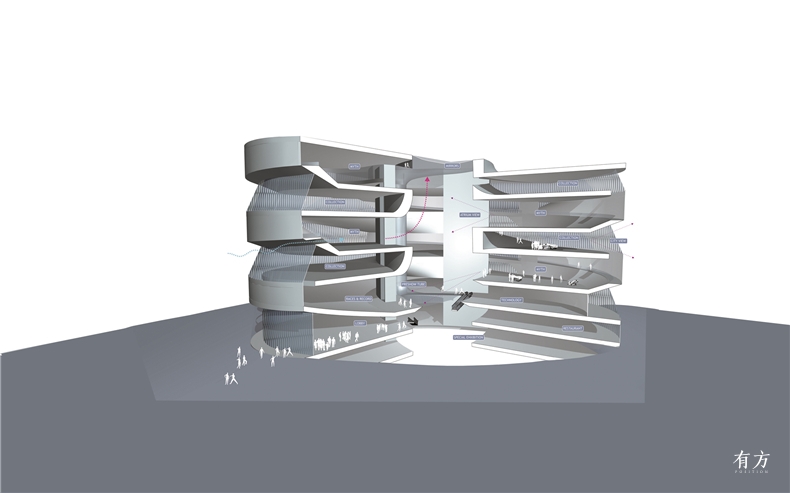
斜面设计决定了博物馆参观者的动线。汽车按照年表的顺序在螺旋轨道上缓缓展开,并由基座维持平衡。我们以这种空间方式讲述着汽车的故事,而不是简单地将物体悬挂或放置在彼此旁边。运动方式及运动的机器即博物馆本质所在。
The mobility of the museum visitor is enforced by the oblique surfaces. The chronology of the car unfolds along a spiraling trajectory, which is counter-balanced by the horizontal platforms that provide restfulness. Telling the story of the car in this spatial manner, instead of simply hanging or placing objects next to each other is telling the story of automobility. Movement and the machines that produce it are intrinsic to the Museum and its contents.
对机器的尊崇一直以来都体现在建筑设计上。许多建筑师想要达到机器的高效率,因为效仿技术智能、紧凑性和机器的现代性。而梅赛德斯—奔驰博物馆则直接展示了这些机器。亮眼的物体可以从各个方向接近,并引起了观众注意。所有关于人类日常行为的细节都暴露无遗。当你继续前进时,物体只会从你的视线内慢慢消失。渐渐地,你会把它们留在你身后。机器还在,而你才是运动着的。
The veneration of the machine runs deep in architecture; many architects have wanted to emulate the efficiency, the technological intelligence, the compactness, the very modeity of machines in their buildings. The Mercedes-Benz Museum showcases the machines themselves. The shiny objects can be approached from all sides and evoke the same focused attention in the viewer as that which caused their existence in the first place. All the details speaking of everyday human actions are exposed. As you walk on, the object only slowly fades from your angle of vision. Gradually, you leave it behind you. The machines are still; you are the one who moves.
这座建筑物围绕在你身边时,就像一个充满矛盾的雕塑体;有时你会看到东西和人,有时你看不到。你需要花6个小时才能看完每辆车,展览看上去好似永不会结束。这肯定会让你多来访几次以便搞懂这个建筑。在任何时候,你都很难知道你的确切位置。你可以在错误的地方进入正确的空间,或者你可以在错误的空间中找到合适的位置。建筑不断展开,让你惊喜不已,但是你不能迷失方向。
The building twist and tus around you like a sculpture full of contrapposto; now you see things and people, now you don’t. It would take you six hours to see every car, every display of the winding exhibition without ends. It will certainly take you several visits to figure the building out. At any point, it is difficult to know where you are precisely. You can be in the right space in the wrong place, or you can be in the right place in the wrong space. The building keeps unfolding, keeps surprising you. But you cannot lose your way.
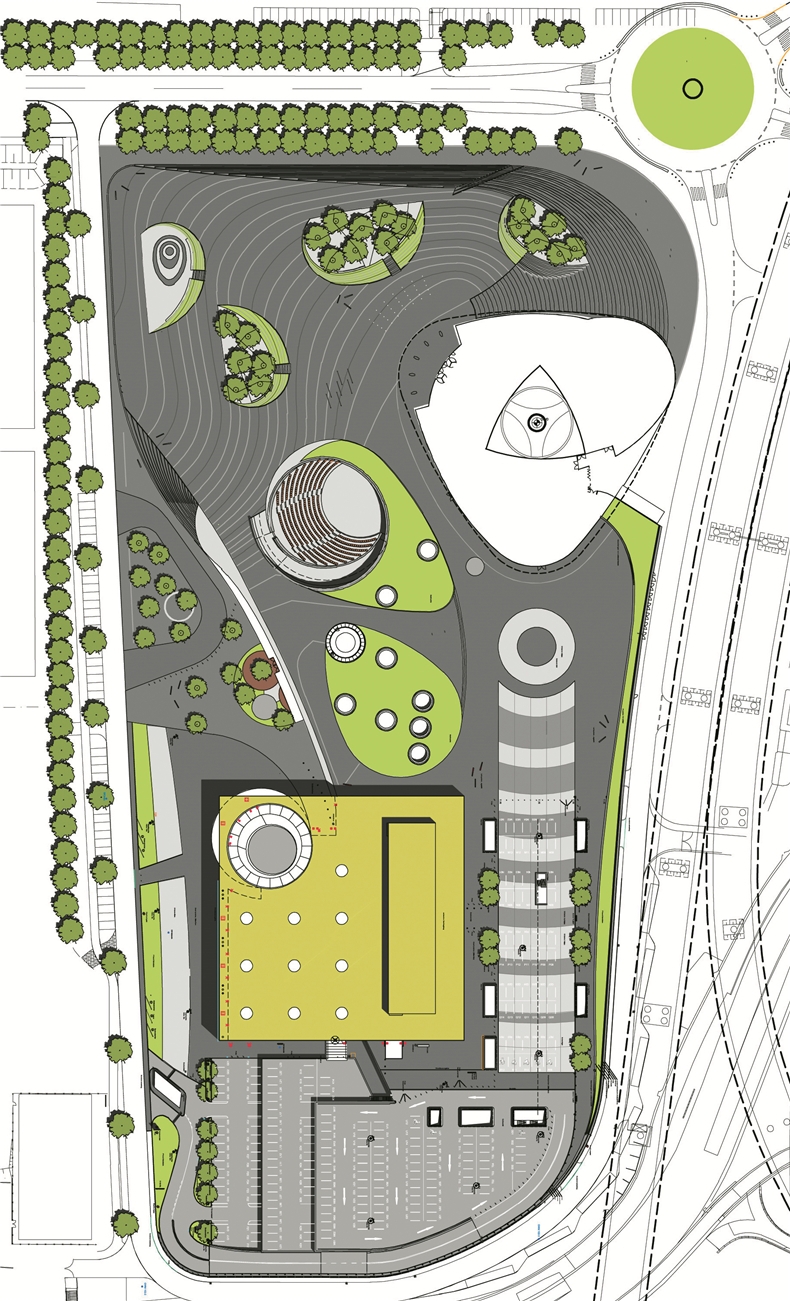
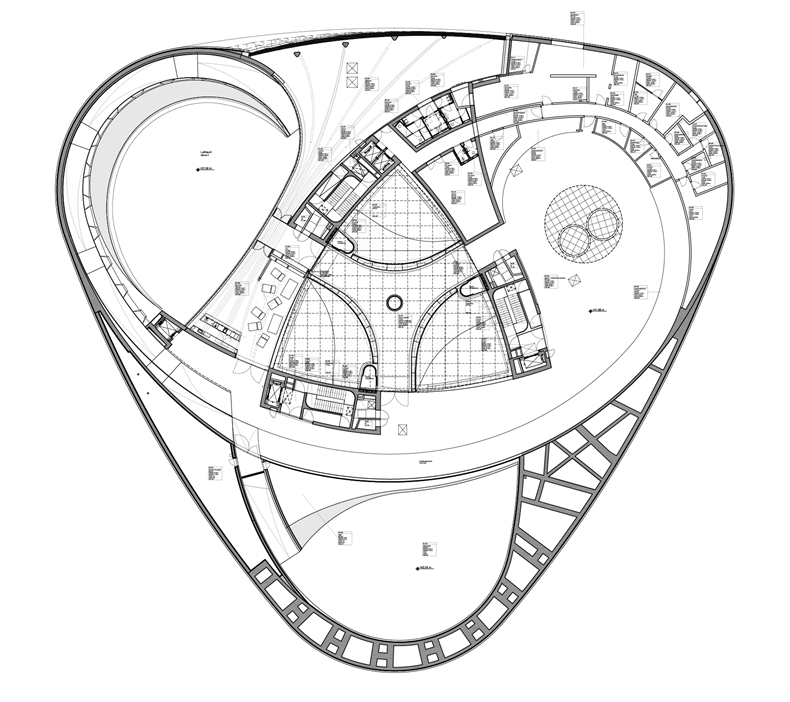
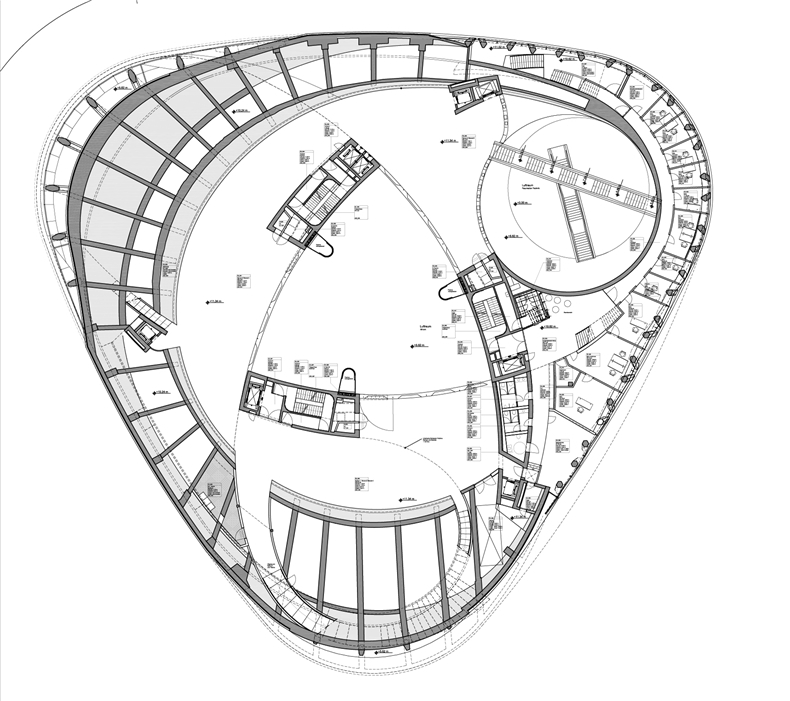
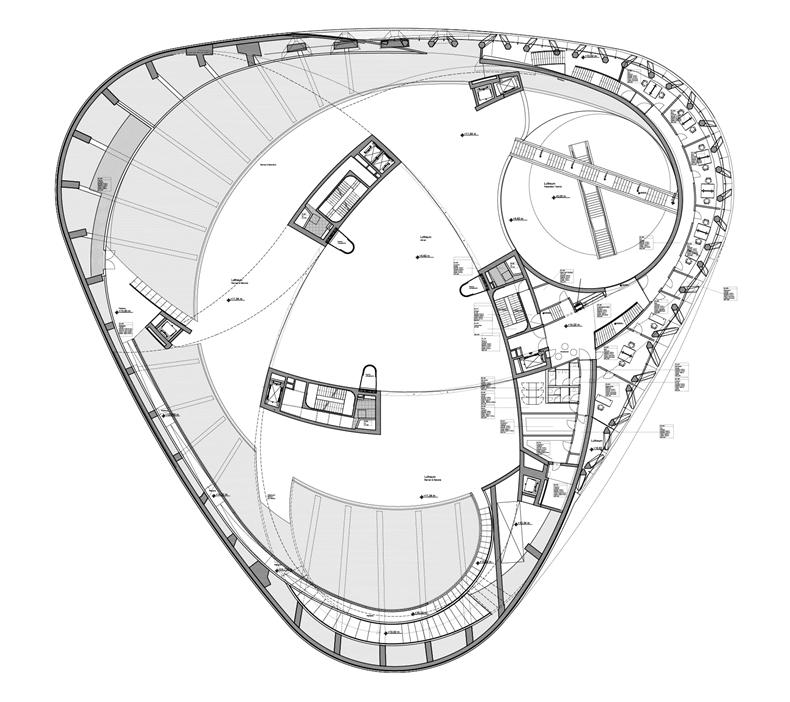
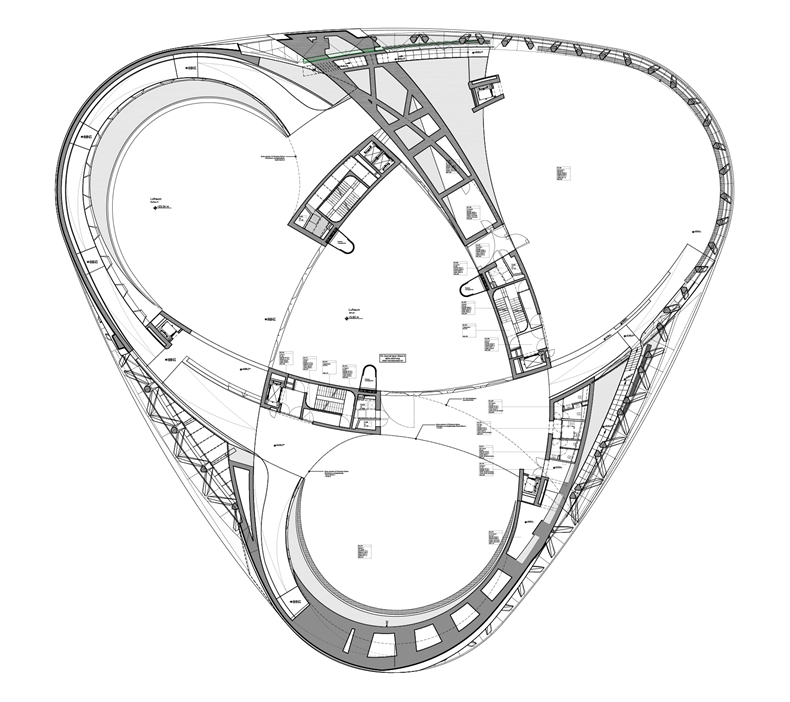
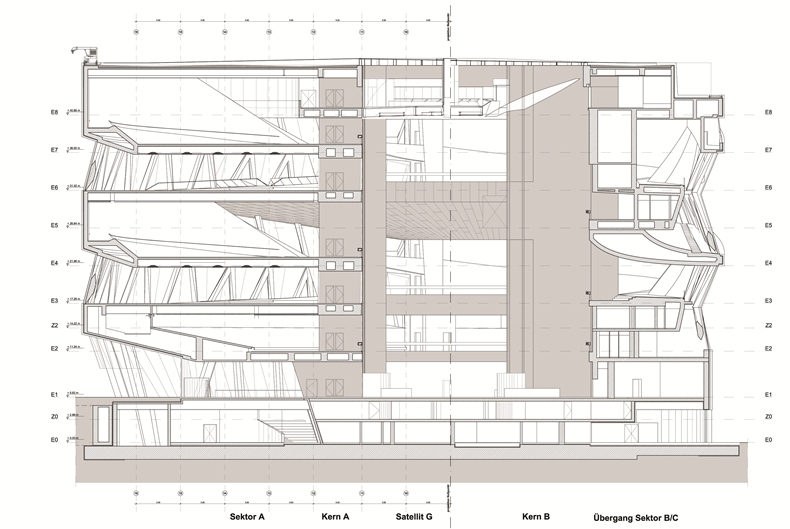
完整项目信息
Inauguration: 19 May 2006
Architect: UNStudio van Berkel & Bos, Amsterdam
Museum design: Prof. H.G. Merz, Stuttgart
Builder/owner: DaimlerChrysler Immobilien (DCI) GmbH
Height of the building: 47.5 meters
Total area: Approx. 53,000 sq. meters
Floor space: 4,800 sq. meters
Exhibition space: 16,500 sq. meters
Interior space: 210,000 cubic meters
Levels: 9
Number of vehicles exhibited: 175
版权声明:本文由UNStudio授权有方发布,禁止以有方编辑后版本转载。
上一篇:山、冰川与大地:格陵兰岛新机场方案 / ZESO & COWI & Masanti
下一篇:雪山下的田园牧歌:青普丽江白沙文化行馆 / 堤由匡建筑设计